Paintings (of a Female Friend) and Titles of Paintings Yet To Be Created
sitemap
drawings
paintings
installations 1 2 3 4 5 6 7
projects
reviews
Milan Golob
Paintings (of a Female Friend) and Titles of Paintings Yet To Be Created
2023, UGM Studio, Maribor, Slovenia
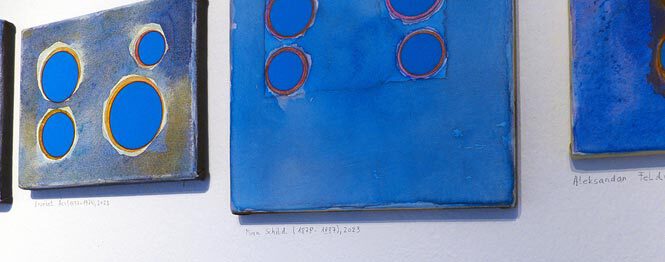
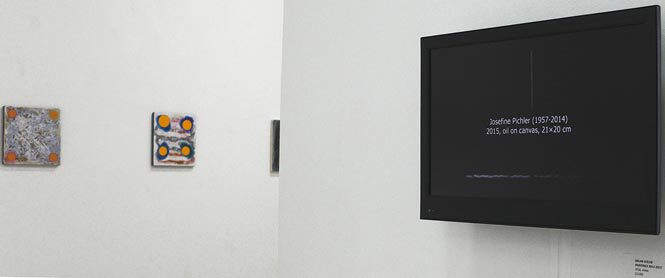

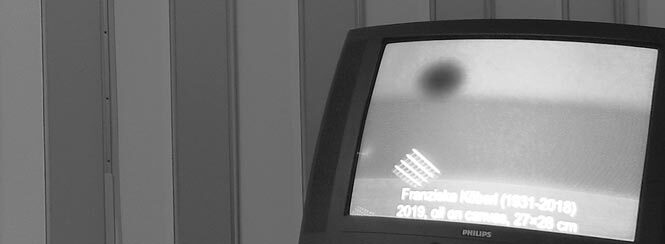
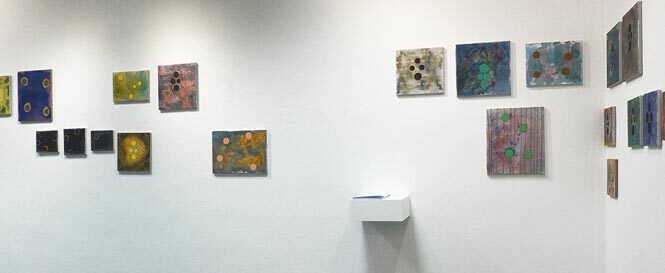
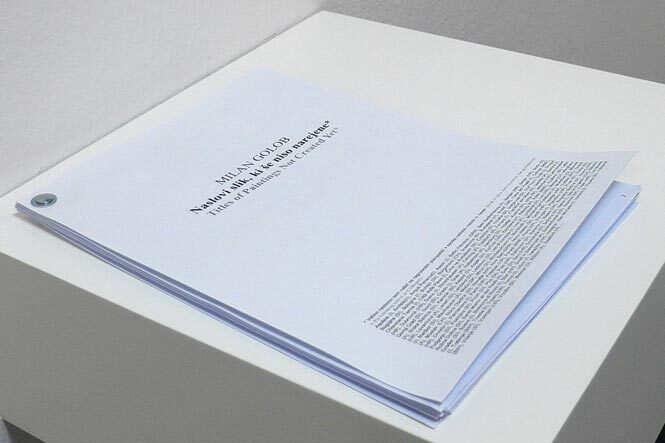
Milan Golob
Paintings (of a Female Friend) and Titles of Paintings Yet To Be Created
2023, UGM Studio, Maribor, Slovenia
Milan Golob
Paintings (of a Female Friend) and Titles of Paintings Yet To Be Created
(The accompanying text for solo exhibition bearing the same title in the UGM studio Maribor, Slovenia, 2023.)
Twenty years ago, four circles occurred randomly in a painting of mine and remained my painting constant; everything else has altered since then. Beginnings have always been delicate. The image of the circle may attest to the incapacity to truly begin, but it also attests to the incapacity to authentically repeat. Philosophy supports the idiot, being a man without assumptions. The paintings' dimensions have also been decreased significantly, but the space of my activity, which is propelled by the paintings, has grown. Soon, but continuously and randomly, I began to name these paintings after departed people (first and last name, birth and death years), initially, after persons who have spiritually inspired me in some way. But nowadays, most of the names for the paintings come from gravestones at cemeteries[1] all throughout Europe. There are presently 6,784 titles awaiting my creation of an artwork for them. Every year, I create 40 to 100 small-size abstract paintings with four circles in the image. The paintings are only finished when I assign or choose a title at random from my arsenal of titles.
I am not interested in the stories of people whose names and surnames, as well as their birth and death dates, happen to be the titles of my paintings, and the titles of the paintings have no bearing on the final visual image. If only the image titles were important, it would be much easier to utilize these names to identify identical monochrome ready-mades of the same size. However, for me, the image is only a full whole when combined with the title. Even if a single image is visually compelling, it is impaired without a title, and vice versa.
The plebeians have never been given names. And it was vital to keep slaves ignorant in order to stop them from rebelling. The Russian modernists, Stalin, Gorky, and many others envisioned a society in which people no longer had names but instead were simply given a letter and a reference to where they worked. Composition f, Construction z, Untitled 3, etc
Every few years, I produce a video[2] of the paintings I created in which I read the titles of the images, which are displayed as subtitles in the video. The painting's title is crucial. Marcel Duchamp was absolutely right when he said that the title is like an invisible colour.
The resemblance of the paintings from this period is always external (four circles), but the core (repetition) of my paintings is always the difference, no matter how great or small. The surface has an innate ability to reconcile the disparity, but only on the surface.
I do not understand why I enjoy making my work more difficult by choosing canvasses of arbitrary but disparate proportions. Furthermore, I am not certain that the information seen on gravestones is entirely accurate. The arrangement of the captioned artworks in this space is entirely accidental. First there was a name, and now my painting's title includes that name. Wittgenstein might have wondered how little of a thought it took to occupy so much of my life already. It is possible that everything is a jumbled mess. I have always excelled at that.
According to Gilles Deleuze[3], repetition is a transgression in every respect. I act and create something new, that is to say, freedom, out of repetition. I oppose repetition to the laws of nature. The essential and non-essential are inextricably intertwined. Meaning and meaninglessness are intertwined. First, there were people with names, which became part of the titles of my paintings. Repetition alters something in the spirit that contemplates it. Only in another time and space will we be able to relearn what we have all forgotten. The problem with habit that is not repetition is that it is subordinate to pleasure.
The point is in the problem itself. "Learning" always occurs in the unconscious. Postulates that do not require verbalization perform better in silence. The history of painting is also a place of absurdity and foolishness. Perhaps it needs Apollo, the thinker of the clear—unclear, to contemplate Dionysus' concepts in order to recreate light. But the world would not exist if everything were worthy and right.
Repetition is never repetition of the "Same", but always repetition of the "Different" as such, and difference itself has repetition as its object. Genital thinking, on the other hand, always leads the Self to think only when it thinks its own passion in the pure and empty form of time. Parlance repeats the past that was never present in the first place. Yes, there is something that compels one to think.
My painting does not imitate, but that is mostly because it repeats, and it repeats all repetitions. Integrating my paintings into the daily existence is an insoluble aesthetic issue. Painting titles are historically an invention of the market, but I am not on friendly terms with it. The universe of my painting[4] (my spirit) is conditioned not just by looking at it and immersing in it, but also by the possibility of doing so.
It makes no difference where you begin to view the exhibition; if and for as long as you are tempted, you will continue, and you are not required to see everything. Do not look for the beginning. The paintings you do not see or are not displayed are not any worse; you just have not seen them. What happens if nothing occurs? Perhaps a gnostic utopia on how to defeat death. It occurred to me that I am a moron.
I am not sure why the title of this exhibition should have anything to do with this text, but it might.
(Translated by Ksenija Vidic)
Notes
[1] I take pictures of gravestones that catch my eye by chance due to an unusual inscription or shape. I then transcribe the titles of the paintings that have yet to be created from the photographs at home and archive the photographs so that, if required, I can figure out where I found the title years later.
[2] The videos are shot with rudimentary, outdated electronic equipment (for example Olympus SP 310). The videos are small-sized (320 × 240 px or 640 × 480 px) and in black and white. I recorded the sound with a ten-year-old classic mobile phone (Samsung GT-C3590). I process and combine everything by using, for example, Videopad and Audacity.
[3] Gilles Deleuze, Difference and Repetition, translated by Paul Patton, Columbia University Press New York 1994.
[4] Painting is a thing of the mind (La pittura è cosa mentale), said Leonardo da Vinci.
Milan Golob; Paintings (of a Female Friend) and Titles of Paintings Yet To Be Created, 2023, UGM Studio, Maribor
Paintings (of a Female Friend) and Titles of Paintings Yet To Be Created
― Dawn Ades, Neil Cox and David Hopkins (eds); Marcel Duchamp, London and New York: Thames & Hudson, 1999.
― Dawn Ades; “Duchamp’s Masquerades.” In The Portrait in Photography, edited by Graham Clarke, 94-114. London: Reaktion, 1992.
― Craig E. Adcock; Marcel Duchamp’s Notes from the “Large Glass”: An N-Dimensional Analysis. Ann Arbor, MI: UMI Research Press, 1983.
― Anonymous; ‘Art was a Dream’ (interview with Marcel Duchamp), Newsweek, vol. 54, no. 19 (New York, 9 November 1959).
― Anonymous; ‘Artist Marcel Duchamp Visits U-classes, Exhibits at Walker’, Minnesota Daily (22 October 1965).
― Anonymous; ‘Growing up absurd’, The Observer (London, 19 June 1966).
― Guillaume Apollinaire; The Cubist Painters: Aesthetic Meditations, New York: Wittenborn, 1970.
― Arts Council of Great Britain (ed.); The Almost Complete Works of Marcel Duchamp, Tate Gallery, London (exh. cat.), June-July 1966.
― Beryl Barr and Barbara Turner Sachs (eds); Artist’s and Writer’s Cookbook, Sausalito: Contact Editions, 1961.
― Giantranco Baruchello and Henry Martin; Why Duchamp. An Essay on Aesthetic Impact, New York: McPherson, 1985.
― Carlos Basualdo and Erica F. Battle (eds); Dancing Around the Bride. Cage, Cunningham, Rauschenberg, and Duchamp, Philadelphia Museum of Art, 30 October 2012-21 January 2013, and Barbican Art Gallery, London, 14 February-9 June 2013 (exh. cat.), New Haven: Yale University Press, 2012.
― Daniel Birnbaum and Annika Gunarsson (eds); Picasso/Duchamp. ‘He was wrong!’, Moderna Museet, Stockholm (exh. cat.), 25 August 2012-3 March 2013, London: Koenig Books, 2012.
― Rudi Blesh; Modern Art USA. Men, Rebellion, Conguest. 1900-1956, New York: Alfred Knopf, 1956.
― Ecke Bonk; Marcel Duchamp: The Portable Museum, London and New York: Thames & Hudson, 1989.
― Leroy C. Breunig; Apollinaire on Art. Essays and Reviews, 1902-1918, Boston: MFA Publications, 2001.
― André Breton; ‘Lighthouse of the Bride’, Minotaure, no. 6, winter 1935, translated by Simon Watson Taylor in André Breton, Surrealism and Painting, 1972, and in the special issue of View dedicated to Duchamp, March 1945.
― Milton W. Brown; The Story of the Armory Show, New York: Abbeville, 1988.
― Pierre Cabanne; Dialogues with Marcel Duchamp, New York: Da Capo, 1987.
― William A. Camfield; Marcel Duchamp. Fountain, Houston: Houston Fine Art Press, 1989.
― John Canaday; ‘Philadelphia Museum Shows Final Duchamp Work’, New York Times (7 July 1969), reprint Philadelphia Museum of Art: Education Division, 1973.
― Bonnie Clearwater (ed.); West Coast Duchamp, Miami Beach: Grasstield, 1991.
― William Copley; ‘The New Piece’, Art in America, vol. 57, no. 4 (New York, July-August 1969).
― J. Michael Dash; Edouard Glissant, Cambridge: Cambridge University Press, 2010.
― Marc Décimo (ed.); Marcel Duchamp and Eroticism. Newcastle, UK: Cambridge Scholars Publishing, 2007.
― T. J. Demos; The Exiles of Marcel Duchamp. Cambridge, MA: MIT Press, 2007.
― Leah Dickerman; Inventing Abstraction, 1910-1925. How a Radical Idea Changed Modern Art, Museum of Modern Art, New York (exh. cat.), 23 December 2012—15 April 2013.
― Katherine S. Dreier and Matta Echaurren; Duchamp’s Glass. An Analytical Reflection, New York: Société Anonyme, 1944.
― Marcel Duchamp, ‘The Mary Reynolds Collection’, in Hugh Edwards (ed.); Surrealism and its Affinities. The Mary Reynolds Collection, Chicago: The Art Institute of Chicago, 1956 (1973).
― Marcel Duchamp; A l'infinitif (The White Box), translated by Cleve Gray, 1967; in the infinitive, a typotranslation by Jackie Matisse, Richard Hamilton and Ecke Bonk, 1999.
― Marcel Duchamp; Marcel Duchamp, Étant Donnés, Manual of Instructions, Yale: Yale University Press, 2009.
― Thierry de Duve; Pictorial Nominalism: On Marcel Duchamp's Passage from Painting to the Ready-made, Minneapolis: University of Minnesota Press, 1991.
― Thierry de Duve (ed.); The Definitively Unfinished Marcel Duchamp, 1991.
― Laurie Eglington; ‘Marcel Duchamp, Back in America, Gives Interview’, Art News, vol. 32, no. 7 (New York, 18 November 1933).
― Dietmar Elger; Dadaism, Cologne: Taschen, 2004.
― Elena Filipovic; The Apparently Marginal Activities of Marcel Duchamp. Cambridge, MA: MIT Press, 2016.
― Tracy Fitzpatrick; Art and the Subway: New York Underground, New Brunswick: Rutgers University Press, 2009.
― James Fitzsimmons; ‘Art’, Arts & Decoration (February 1953).
― Charles Henri Ford (ed.); View, vol. 5, no. 1 (New York, March 1945).
― Charles Henri Ford (ed.); View: Parade of the Avant-Garde. New York: Thunder’s Mouth, 1991.
― Helmut Friedl, Thomas Girst, Matthias Mühling and Felicia Rappe (eds); Marcel Duchamp in Munich 1912, Lenbachhaus Munich (exh. cat.), Munich: Prestel, 2012.
― William Furlong (ed.); Audio Arts Magazine, vol. 2, no. 4 (London, 1976).
― Thomas Girst; The Indefinite Duchamp, Ostfildern: Hatje Cantz, 2013.
― Thomas Girst; A Duchamp Dictionary, 2014.
― Laurence Stephen Gold; A Discussion of Marcel Duchamp’s Views on the Nature of Reality and Their Relations to the Course of His Artistic Career, BA dissertation, Princeton University, May 1958.
― John Golding; Marcel Duchamp: The Bride Stripped Bare by Her Bachelors, Even, 1973.
― Cleve Gray; ‘Marcel Duchamp 1887-1968. The Great Spectator’, Art in America, vol. 57, no. 4 (New York, July-August, 1969).
― Peggy Guggenheim; Out of this Century. Confessions of an Art Addict, London: André Deutsch, 2006 (1979).
― Richard Hamilton; ‘Foreword’, in Not Seen and/or Less Seen of/by Marcel Duchamp/Rrose Sélavy 1904-1964 (exh. cat. for the Mary Sisler Collection), New York: Cordier & Ekstrom, 1965.
― Richard Hamilton and Ecke Bonk (eds); Marcel Duchamp, À l’infinitif: In the Infinitive. A Typotranslation, Cologne: Walther Konig, 1999.
― Richard Hamilton; The Bride Stripped Bare by Her Bachelors, Even, a typographic version of Marcel Duchamp’s Green Box, translated by George Heard Hamilton, 1960.
― Richard Hamilton; The Almost Complete Works of Marcel Duchamp, exh. cat., Tate Gallery, 1966.
― Susan Hapgood; Neo-Dada. Redefining Art 1958-1962 (exh. cat.), New York: American Federation of Arts, 1994.
― Anne d’Harnoncourt and Walter Hopps; ‘Ėtant Donnés: 1. La chute d’eau, 2. Le gaz d’éclairage. Reflections on a New Work by Marcel Duchamp’, Philadelphia Museum of Art Bulletin, vol. 64, nos. 299 and 300 (April-September 1969).
― Charles Harrison and Paul Wood (eds); Art in Theory 1900-1990, Oxford: Blackwell, 1992.
― Linda Dalrymple Henderson; Duchamp in Context. Science and Technology in the Large Glass and Related Works, Princeton: Princeton University Press, 1998.
― Anthony Hill (ed.); Duchamp: Passim, A Marcel Duchamp Anthology, Langhorne, PA: G+B Arts International, 1994. (Contains several interviews and lectures, including the 1959 BBC interview with George Heard Hamilton and Richard Hamilton.)
― David Hopkins; Marcel Duchamp and Max Ernst. The Bride Shared. Oxford: Clarendon, 1998.
― David Hopkins; Dada’s Boys: Masculinity After Duchamp, 2007.
― Walter Hopps (ed.); By or Of Marcel Duchamp or Rrose Sélavy. A Retrospective Exhibition, Pasadena Art Museum (exh. cat.), 8 October-3 November 1963.
― Pontus Hultén (ed.); Marcel Duchamp, Cambridge: MI'T Press, 1993 (including Jennifer Gough-Cooper and Jacques Caumont, ‘Ephemerides on and about Marcel Duchamp and Rrose Sélavy, 1887-1968’).
― Jasper Johns; ‘Thoughts on Duchamp’, Art in America, vol. 57, no. 4 (New York, July-August 1969).
― Amelia Jones; Postmodernism and the En-Gendering of Marcel Duchamp. Cambridge: Cambridge University Press, 1994.
― Dalia Judovitz; Unpacking Duchamp: Art in Transit. Berkeley: University of California Press, 1995.
― Lewis Kachur; Marcel Duchamp, Salvador Dali, and Surrealist Exhibition Installations. Cambridge, MA: MIT Press, 2001.
― Susanne M. I. Kaufmann (ed.); Marcel Duchamp: 100 Questions, 100 Answers, exh. cat., Staatsgalerie, Stuttgart, 2018-19 (includes Duchamp’s answers to Serge Stauffer’s questions).
― Rudolf E. Kuenzli and Francis M. Naumann (eds); Marcel Duchamp. Artist of the Century, Cambridge: MI'T, 1989.
― Katherine Kuh; ‘Marcel Duchamp’ (1961), in The Artist’s Voice: Talks with Seventeen Modern Artists, New York: Da Capo, 2000.
― Katherine Kuh; The Open Eye: In Pursuit of Art. New York: Harper and Row, 1971.
― Robert Lebel; Marcel Duchamp, New York: Grove Press, 1959 (1996).
― Robert Lebel; ‘The Ethic of the Object’, Art and Artist, vol. 1, no. 4 (London, July 1966).
― Michael Leja; Looking Askance: Skepticism and American Art from Deakins to Duchamp, California: University of California Press, 2007.
― David Leopold (ed); Max Stirner, The Ego and Its Own, Cambridge: Cambridge University Press, 1995.
― Julien Levy; Surrealism, New York: Black Sun Press, 1936.
― Julien Levy; Memoirs of an Art Gallery, New York: Putnam, 1977.
― Jean Francois Lyotard; Duchamp’s TRANS/ - formers, Venice, CA: Lapis, 1990.
― Henry McBride; ‘The Nude-Descending-a-Staircase Man Surveys Us’, The New York Tribune (12 September 1915).
― Alice Goldtarb Marquis; Marcel Duchamp. The Bachelor Stripped Bare, Boston: MFA Publications, 2002.
― Joseph Mashek (ed.); Marcel Duchamp in Perspective, Englewood Clifts: Prentice Hall, 1975.
― Paul Matisse (ed.); Marcel Duchamp, Notes, Boston: G. K. Hall, 1983.
― Herbert Molderings; Duchamp and the Aesthetics of Chance, 2010.
― Robert Motherwell (ed.); The Dada Painters and Poets. An Anthology, Cambridge: Harvard University Press, 1988 (1951).
― Gloria Moure; Marcel Duchamp. Works, Writings, Interviews, Barcelona: Ediciones Poligratfa, 2009.
― Museum Jean Tinguely Basel (ed.); Marcel Duchamp (exh. cat.), Ostfildern: Hatje Cantz, 2002.
― Francis M. Naumann; New York Dada, 1915-1923, New York: Abrams, 1994.
― Francis M. Naumann; Marcel Duchamp. The Art of Making Art in the Age of Mechanical Reproduction, New York: Abrams, 1999.
― Francis M. Naumann; The Recurrent, Haunting Ghost. Essays on the Art, Life and Legacy of Marcel Duchamp, New York: Readymade Press, 2012.
― Francis M. Naumann (ed.); Marcel Duchamp, ‘Nude Descending a Staircase: An Homage’, Francis M. Naumann Fine Art, New York, 15 February-29 March 2013.
― Francis M. Naumann and Bradley Bailey; Marcel Duchamp. The Art of Chess, New York: Readymade Press, 2009.
― Francis M. Naumann and Jeftrey Deitch (eds), Maria. The Surrealist Sculpture of Maria Martins, André Emmerich Gallery, New York (exh. cat.), 19 March-18 April 1998.
― Francis M. Naumann and Hector Obalk (eds); Affect. Marcel. The Selected Correspondence of Marcel Duchamp, London and New York: Thames & Hudson, 2000.
― James Nelson (ed.); Wisdom: Conversations with the Elder Wise Men of our Day, New York: Norton, 1958.
― Anaïs Nin; The Diary 1931-1934, New York: Harcourt, Brace and World, 1966.
― John P. O'Nelll (ed.); Barnett Newman, Selected Writings and Interviews, New York: Alfred A. Knopf, 1990.
― Gavin Parkinson; The Duchamp Book, 2008.
― Octavio Paz; Marcel Duchamp or the Castle of Purity, London: Cape Golliard, 1970.
― Mark Polizzotti; Revolution of the Mind: The Life of André Breton. New York: Farrar, Straus and Giroux, 1995.
― Stuart Preston; ‘Diverse Facets: Moderns in Wide Variety’, New York Times, section 10 (20 December 1953).
― Man Ray; ‘On July 28, 1968 ...’, Art in America, vol. 57, no. 4 (New York, July-August 1969).
― Man Ray; ‘Bilingual Biography. I and Marcel: A Dual Portrait of Thirty Years’ (1945), Opus International, no. 49 (Paris, March 1974).
― Man Ray; Self-Portrait, London: Bloomsbury, 1988.
― Francis Roberts; ‘I Propose to Strain the Laws of Physics’, 1963, interview with Marcel Duchamp, Art News, vol. 67, no. 8, December 1968.
― Hans Richter; Dada: Art and Anti-Art, London and New York: Thames & Hudson, 1965.
― Hans Richter; ‘In Memory of a Friend’, Art in America, vol. 57, no. 4 (New York, July-August, 1969).
― John Russell; ‘Assembling Scattered Works by the Cognescenti’s Painter’, New York Times (28 November 2001).
― Michel Sanouillet and Elmer Peterson (eds); The Writings of Marcel Duchamp, New York: Da Capo, 1989.
― Lydie Fischer Sarazin-Levassor; A Marriage in Check: The Heart of the Bride Stripped Bare by Her Bachelor, Even, Dijon: Les Presses du Reel, 2007.
― Winthrop Sargeant; ‘Dada’s Daddy’, Life, vol. 32, no. 17 (New York, 28 April 1922).
― Harold C. Schonberg; ‘Creator of Nude Descending Reflects After Half a Century’, New York Times (12 April 1963).
― Arturo Schwarz; The Complete Works of Marcel Duchamp, New York: Delano Greenidge, 2000.
― Gil Scott-Heron; Now and Then. The Poems of G2l Scott-Heron, Edinburgh: Payback, 1990.
― William Seitz; “What Happened to Art? An Interview with Marcel Duchamp on Present Consequences of New York’s 1913 Armory Show’, Vogue, vol. 141, no. 4 (New York, 15 February 1963).
― Laurence D. Steetel Jr; The Position of Duchamp’s ‘Glass’ in the Development of his Art, New York and London: Garland Publications, Inc., 1977.
― Alfred Stieglitz; ‘Letter to the Editor’ (13 April 1917), The Blind Man, no. 2 (New York, May 1917).
― Alfred Stieglitz; ‘Can Photography have the Significance of Art?’, Manuscripts, no. 4 (New York, December 1922).
― James Johnson Sweeney; ‘Eleven Europeans in America’, The Museum of Art Bulletin, vol. 13, nos. 4-5 (New York, 1946).
― Michael Taylor; Ėtant donnés, Philadelphia: Philadelphia Museum of Art, 2009.
― Edward W. Titus (ed.); This Quarter. Surrealist Number, Paris: The Black Manikin Press, 1982.
― Calvin Tomkins; The Bride and the Bachelors. Five Masters of the Avant-Garde: Duchamp, Tinguely, Cage, Rauschenberg, Cunningham, New York: Penguin, 1976.
― Calvin Tomkins; Duchamp. A Biography, New York: Holt, 1996 (1998).
― Calvin Tomkins; Marcel Duchamp. The Afternoon Interviews, New York: Badlands Unlimited, 2013.
― Calvin Tompkins; The Bride and the Bachelors: The Heretical Courtship of Modern Art. New York: Penguin, 1965.
― Radu Vania; Brancusi, New York: Rizzoli, 1986.
― Steven Watson; Strange Bedfellows. The Furst American Avant-Garde, New York: Abbeville Press, 1991.
― Walt Whitman; The Complete Poems, London: Penguin, 1996.
― Beatrice Wood; I Shock Myself, San Francisco: Chronicle Books, 1996.
― Lois Parkinson Zamora; The Usable Past. The Imagination of History in Recent Fiction of the Americas, Cambridge: Cambridge University Press, 1997.